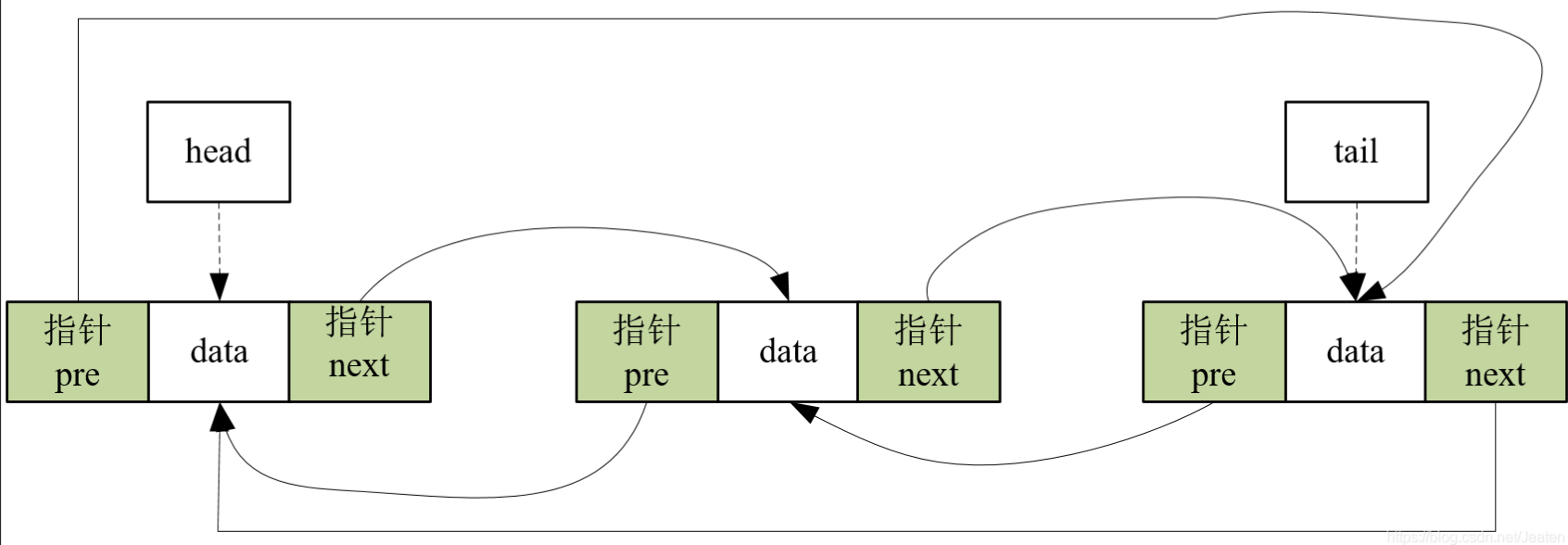链表结构
链表
一、链表的分类
1.1 单项链表
每个node节点指向下一个节点。然后有个head节点指向第一个节点,尾节点指向null。也可以有个last节点指向最后一个节点。这样能快速获取最后一个节点,再增加节点的时候能提升效率。

1.2 双向链表
每个节点都有一个pre变量存储上一个节点的地址,一个next变量存储下下一个节点的地址。最后一个节点的next存储null

1.3 循环链表
循环双向链表:与双向链表不同的是最后一个节点的next存储第一个节点的地址。第一个节点的pre存储最后一个节点地址。

循环单项链表也差不多。
二、代码简易实现
import java.util.*; public class THS { public static void main(String[] args) { List<Integer> list = new List<>(); list.linkLast(1); list.linkLast(2); list.linkLast(3); list.linkFirst(4); list.linkFirst(5); list.linkFirst(6); list.remove(5); list.printLink(); } } //节点 class Node<E> { //存储当前节点的值 E item; //存储下一个节点的地址 Node<E> next; //存储上一个节点的地址 Node<E> prev; public Node(Node<E> prev, E element, Node<E> next) { this.item = element; this.next = next; this.prev = prev; } } class List<E>{ Node<E> first; Node<E> last; //头插节点 void linkFirst(E e){ Node<E> f = first; Node<E> temp = new Node<>(null,e,f); first = temp; if(f == null){ last = temp; }else{ f.prev = temp; } } //尾插节点 void linkLast(E e){ Node<E> l = last; Node<E> temp = new Node<>(l,e,null); last = temp; if (l == null){ first = temp; }else{ l.next = temp; } } boolean remove(Object o) { if (o == null) { for (Node<E> x = first; x != null; x = x.next) { if (x.item == null) { unLink(x); return true; } } } else { for (Node<E> x = first; x != null; x = x.next) { if (o.equals(x.item)) { unLink(x); return true; } } } return false; } //移除节点 void unLink(Node<E> e){ Node<E> preNode = e.prev; Node<E> nextNode = e.next; if (preNode == null){ first = nextNode; }else { preNode.next = nextNode; e.prev = null; } if(nextNode == null){ last = preNode; }else{ nextNode.prev = preNode; e.next = null; } e.item = null; } void printLink(){ if(first == null){ System.out.println("空链表!!!"); }else{ Node<E> temp = first; while (temp!=null){ System.out.println(temp.item); temp = temp.next; } } } } /**单例模式*/ //懒汉 class Singleton1{ private static Singleton1 instance = null; private Singleton1(){} public static Singleton1 getInstance(){ if (instance != null){ instance = new Singleton1(); } return instance; } } //饿汉 class Singleton2{ private static final Singleton2 instance = new Singleton2(); private Singleton2(){} public static Singleton2 getInstance(){ return instance; } } //枚举 class Singleton3{ private Singleton3(){} private enum Singleton{ INSTANCE; private final Singleton3 instance; private Singleton(){ instance = new Singleton3(); } private Singleton3 getInstance(){ return instance; } } public Singleton3 getInstance(){ return Singleton.INSTANCE.getInstance(); } } //双重校验锁 class Singleton4{ private static volatile Singleton4 instance; private Singleton4(){} public static Singleton4 getInstance(){ if(instance == null){ synchronized (instance){ if (instance == null){ instance = new Singleton4(); } } } return instance; } }
三、扩展
1、jdk1.8中LinkedList使用的是双向链表。
2、插入和删除的时间复杂度为o(1),查询为o(n)所以一般再插入删除多的情况下用链表。


